The skies are dreary and grey again, and rain is imminent, but yesterday was a perfect spring day. The sun was shining, and our daffodils are starting to bloom. Last fall we were confronted with the newly denuded hillside that is to become the orchard. Not wishing to stare at bare dirt until the fruit trees were planted, I set out to plant 150 Dutch Master daffodils…and all through winter, remained hopeful that I’d see them in the spring.
I tucked them into the soil for winter, wondering if I’d ever see them again. I’ve never planted daffodils here before, and although when happy where they are they need little care, if planted in heavy soils, subject to excessive rains, or relocated by wildlife, they may simply disappear.
In January though, we began to see signs of life. Maybe they’d bloom after all?
They did! They are! Can you tell I’m excited?
I realize that spring is still three weeks away, but yesterday, with daffodils dancing in the sunshine, it already felt like spring.
Dutch Master is a classic yellow trumpet daffodil. I love all daffodils, but I’m particularly fond of the ‘classic-look’ yellow trumpet varieties.
Dutch Master is usually marketed as a ‘King Alfred’ type. Be aware that Dutch Master is a common garden variety ‘improved daffodil’, easily obtained through catalogs and garden centers, but that the true King Alfred daffodil is an heirloom variety, and less easily obtained. However, I don’t feel that detracts in any way from the beauty of the Dutch Master, and with as much ground to cover as we have here, Dutch Master is proving to be a beautiful, and economical alternative.
Dutch Master flowers are very large, with petals curving slightly forward, and a large trumpet (corona) that is as long, or longer than the petals.
Our hope is that year over year these bulbs will slowly naturalize across the orchard slope, and no doubt we’ll add some additional varieties in time, if only to extend the bloom period.
Who Was Narcissus?
Gardeners often refer to daffodils by their genus name, Narcissus, but do you know how this flower aquired that name? The name Narcissus (or Narkissos) is from a Greek myth. Narcissus was a Greek hero who was granted exquisite beauty and immortality by the Gods, but with the warning that he would lose his gift if he ever gazed upon his own reflection. Narcissus by nature was cruel, and rejected the attention lavished on him by those who were attracted to his beauty. A young wood nymph named Echo saw Narcissus while he was out in the woods hunting deer, and she fell head-over-heels in love. Narcissus though had great disdain for those who loved him, and rejected her. Echo was devastated. She is said to have cried until all that was left was her voice.
The goddess Nemesis heard of Echo’s rejection, and was outraged. Nemesis lured Narcissus to the still waters of a small lake, where he gazed upon his own reflection and fell in love…with himself. The curse of the Gods took hold, and Narcissus simply faded away. In his place, on the lake shore, a golden flower appeared…and so this golden flower bears his name, Narcissus.

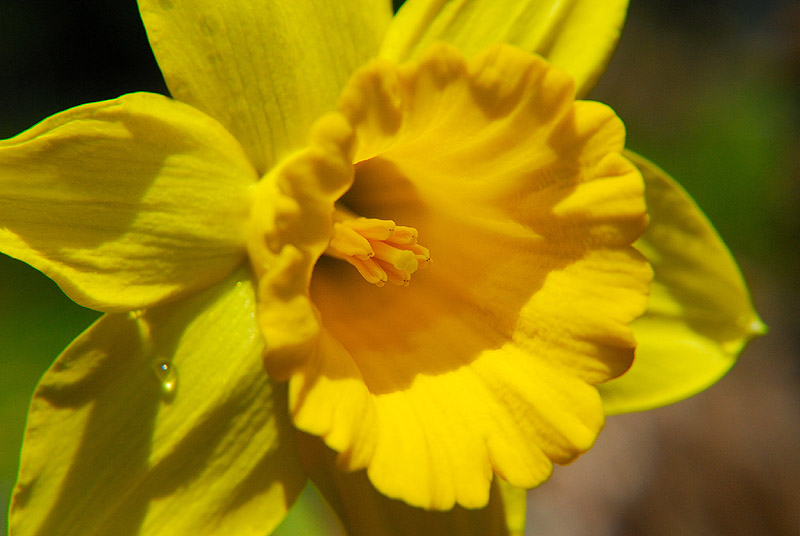
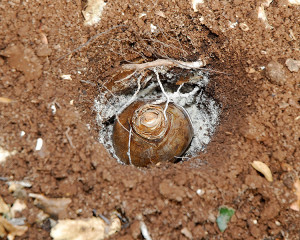
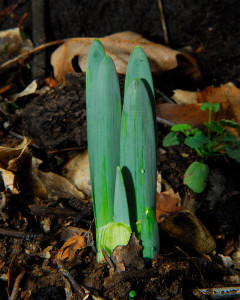
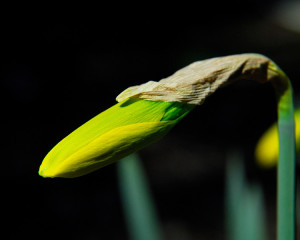
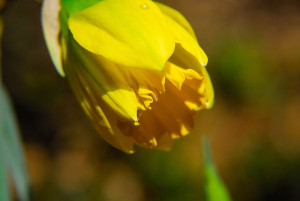
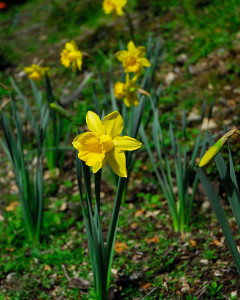
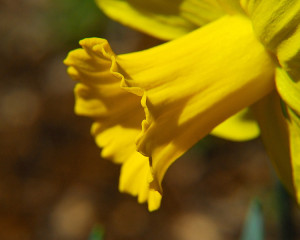
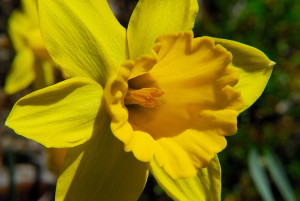

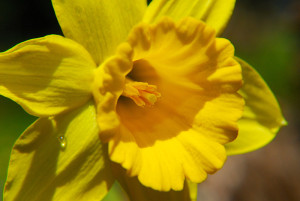
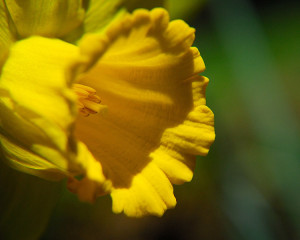
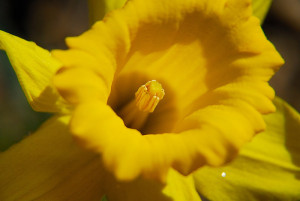
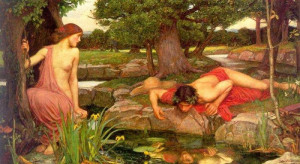







Dear CV, I am so pleased for you. It is such a thrill when something one had doubts about materialises into something approaching what one had hoped for and imagined. I hope the daffodils will give you pleasure for years to come.
Thank you Edith, I hope so too. It’s just such a joy to see something pretty flowering here after two years of poison oak, preparation and ground work. However, it’s a reward that was certainly worth waiting for!
What a great post! Narcissus – this is how this plant is called in Russia. I like it more than Daffodil. Some people can be called N. if they think they are the best.
Love the pictures and the story!
What a wonderful cheerful yellow! If the daffodils are in bloom, it is srping; I don’t care what the calendar says.
Lovely, simply lovely! a hillside of daffodils in the spring… can only imagine the joy you feel looking at them. 😉
That is truly a classic looking daffodil, it’s positively glowing in the sunshine. And I love the background story. I had forgotten my Greek mythology, so it was nice to have a refresher course. 140 bulbs should make for a nice showing indeed when they get naturalized!
Delightful post! Daffs like drainage, so your slope should be just the ticket. I see you share my taste for Waterhouse paintings, as well as daffodils 🙂
Wow – you’re ahead of us. Ours are pushing through, but there’s no sign of the flowers yet.
What a wonderful sight it must be to see 150 daffs waving in the breeze. I look forward to sseing another picture of it a few years in the future, I expect it will be thick with them by then.
Ha, you planted 150? Well, be prepared then. I planted about 25 3 or 4 years ago, and they seem to double each year. Mine get very little water in summer and seem to like that just fine.
Yes, I agree, it’s so cheerful.
(I’m sure you know not to cut the leaves after bloom, I tie some raffia around the dying leaves)
Yellow Trumpets are what come to mind when we hear ‘daffodil.’ What a lovely beginning to the daffodil season!
Oh Town Mouse, that would be exciting. I do hope ours do that well. I’d be absolutely giddy if 300 or so popped up next spring. I did spread them out a bit on the hillside, so they’ll have lots of room to expand. This year they look a little sparse across the hill, but if all goes well they should (cross my fingers) fill in nicely. Yes, thank you, I do know of the raffia trick to help tame the shabby foliage, but it’s so important to leave it attached until it’s really died back. The raffia is nice just so they don’t look so unkempt…although…I might need to buy more raffia 😛
What beautiful daffies CV 🙂 The shot of the tightly closed bud is just lovely. It won’t be long before it’s time for me to start thinking of putting a few daffodils in the garden too(but on a much smaller scale than your 150!)
Yay for daffodils! I can never get enough of them, and seeing yours just made me smile and smile. The beds where mine are planted are still buried in snow, so it’s going to be quite a while yet…but February is almost over. Yee hah!
Wow! I would love to see all those daffodils in bloom at once. Mine are still almost 3 months away.
Very regal indeed. These photos remind me of the daffodils my grandad grew in his garden. He probably had the King Alfred ones.
I planted loads of bulbs last autumn and ended up with blisters on the palms of my hands. I hope your slope wasn’t as stoney as my garden as its hard work digging all those little holes.
Enjoy the rest of your weekend 🙂 Rosie
They look, well, so springlike;-) I can’t believe spring is only 3 wks away…it doesn’t feel like it here! Thanks for sharing your photos! I’m glad your bulbs are opening for you…that’s exciting.
I’ve been told that plaiting is out of favor….
I bought some daffodils for this first time this past winter and threw them in the garden. My husband was so impressed that they just grew up on their own that we went bulb shopping this weekend to keep some flowers blooming all summer. I have about 10 plants and think they are beautiful I can only imagine 150! I plan on keeping adding more every fall so I’ll get back to you in a couple years!
I, too, love the classic yellow daffodil form, and these are perfect! My grandmother had a whole slope colonized with these and when I was a child, I loved to lay down in the early spring grass among them. Those lovely golden cups are filled with nostalgia and poetry.
Loved the review of Greek mythology 101 (I’ve forgotten so much over the years!) and the painting, too.
If you love the look of these and really want to fill in a space fast, I suggest tete-a-tete’s. They are smaller versions of these daffodils. I got some from Home Depot 5 years ago and I am running out of places to move them to!!
Must be my Dutch blood, likes this one!
A perfect post for the perfect trumpet of yellow sunlight filled daffodil or narcissus. Your photos are so bright and cheery to this reader looking out on snow falling over a black and white landscape. I love the fragrance too of these beautiful flowers. I prefer the name daffodil for I have always thought since learning of Narcissus… that a lovely flower should not have to bear an ego maniac’s presence and name. Then it is only a myth and a lesson at that. A hillside of daffs in bloom can surely bring us outside of ourselves! ;>)
There’s nothing so cheerful as a blanket of daffodils. You’re so lucky to have them come up in February. We’ll have a wait for ours. Happy daffodil-arama!
Very lovely photos and very informative post. The yellow daffodils are not growing here in the tropics but we have Hipeastrum puniceum, which i don’t know it it is a daffodil, a lily, or an amaryllis. I assume it is amaryllis though haven’t really studied it. I’ve also posted them in my site.
But i thought there is also a flower named Narcissus spp, is it the same?